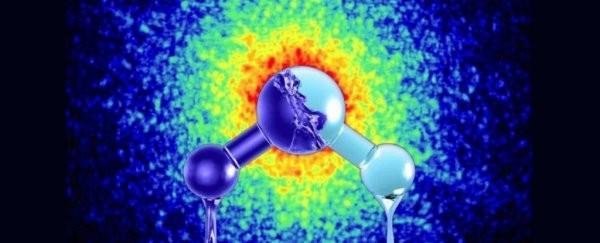Water is one of the most fundamental molecules on Earth, and yet scientists are only just beginning to wrap their heads around how bizarre the substance really is.

Case in point: researchers have now discovered that water exists in not one, but two distinct liquid phases, each with big differences in structure and density.
Using X-rays to study H2O in unprecedented detail, physicists from Stockholm University in Sweden have provided evidence that the liquid water we know and love isn't just a single phase, it is in fact a fluctuation between two forms - high and low density.
"The new results give very strong support to a picture where water at room temperature can't decide in which of the two forms it should be, high or low density, which results in local fluctuations between the two" said one of the researchers, Lars G.M. Pettersson.
"In a nutshell: Water is not a complicated liquid, but two simple liquids with a complicated relationship."
Most of us are taught in high school that water exists in three distinct phases: liquid water, solid ice, and water vapour.
But it's not actually that simple - water can also exist as a strange plasma-like state, and even the standard three phases of water we're familiar with are more bizarre than you'd ever imagine.
For example, with the exception of Mercury, water has the highest surface tension of all liquids, and unlike almost every other known substance, water expands when it freezes.
Also, while the boiling points of other hydrides, such as hydrogen telluride and hydrogen sulphide, decrease as their molecule size decreases, H2O has a surprisingly large boiling point for such a small molecular weight.
In fact, scientists have identified 70 properties of liquid water that are entirely unique from all other liquid substances we know of.
One oddity that's long been debated is whether there's more than one liquid phase of water. This idea is based off the fact that researchers already know that ice can exist in distinct high- and low-density forms.
We're not talking about the ice you pop out of your ice cube trays here - that's what's known as crystalline ice, which is highly ordered with all its individual molecules lined up in a repeating pattern.
But ice also exists in another form known as amorphous ice, where the molecules are more disordered. Although it's not something most of us are familiar with, amorphous ice is likely the most common type of solid water found throughout the Universe, and it can flip between distinct high- and low-density versions.
Because of this, researchers suspected that perhaps liquid water could do the same thing. But until now no one had been able to study its molecular changes in enough detail to figure out exactly what was going on.
The new research used two different types of X-ray imaging to track the movement and distance between H2O molecules as water transitioned from an amorphous, glassy, frozen liquid state, to a viscous liquid, and then another, even more viscous liquid with lower density.
What they saw was evidence of two distinct liquid phases.
"The new remarkable property is that we find that water can exist as two different liquids at low temperatures where ice crystallisation is slow," said one of the researchers, Anders Nilsson.
This is, of course, just one study, and other independent teams will now need to perform their own verification of the research in order to back up the claim before we rewrite the textbooks.
But this isn't the first time scientists have stumbled upon a strange second liquid state of water.
Last year, a team from Oxford University also showed that between 40 and 60 degrees Celsius (104 and 140 degrees Fahrenheit), liquid water could 'switch' states and exhibit a whole new set of properties depending on the state it flips to.
Importantly, this new research adds another important piece to the puzzle that's beginning to gradually reveal just how strange and fascinating this ubiquitous molecule really is.
"No one really understands water," Philip Ball pointed out in Nature last year.
"It's embarrassing to admit it, but the stuff that covers two-thirds of our planet is still a mystery. Worse, the more we look, the more the problems accumulate: new techniques probing deeper into the molecular architecture of liquid water are throwing up more puzzles.
From:http://www.sciencealert.com/physicists-just-showed-water-can-exist-as-two-different-liquids
Hi! I am a robot. I just upvoted you! I found similar content that readers might be interested in:
https://www.sciencealert.com/physicists-just-showed-water-can-exist-as-two-different-liquids
Downvoting a post can decrease pending rewards and make it less visible. Common reasons:
Submit
Yeah, water seems really fascinating.
The kind of thinking that there are only three or only four phases seems outdated by now. Thinking of it as a continuum seems more appropriate. The behavior of the particles changes based on the conditions (temperature, pressure, etc.).
Downvoting a post can decrease pending rewards and make it less visible. Common reasons:
Submit
Congratulations @einsthawkton! You have completed some achievement on Steemit and have been rewarded with new badge(s) :
Click on any badge to view your own Board of Honnor on SteemitBoard.
For more information about SteemitBoard, click here
If you no longer want to receive notifications, reply to this comment with the word
STOPBy upvoting this notification, you can help all Steemit users. Learn how here!
Downvoting a post can decrease pending rewards and make it less visible. Common reasons:
Submit